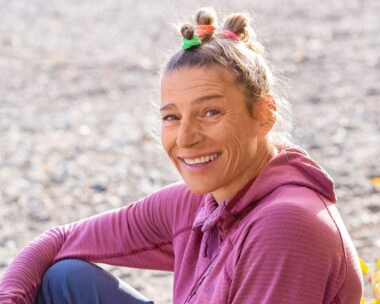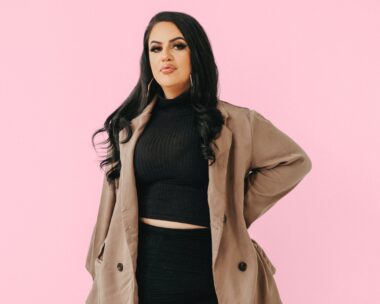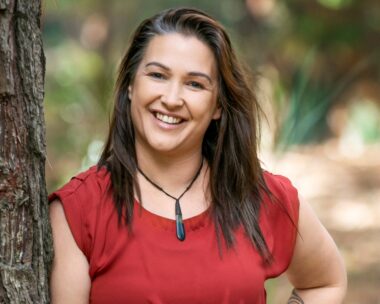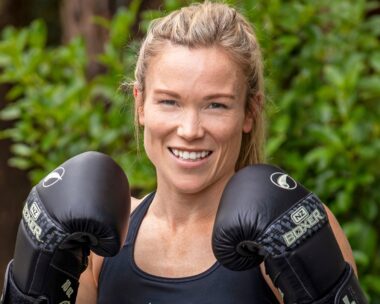Photos of Charley Hooper dot almost every wall of her family’s Hamilton home. The most poignant is a strip of 4D ultra¬sound images, framed in rimu, taken when her mother Jenn was 33 weeks pregnant. “They’re the only ones we’ve got where she was still okay.”
Less than two months after they were taken, Charley was born dark grey, floppy and gasping in a rural maternity unit after her heart rate slowed during labour. Two midwives were unable to resuscitate her properly and she was without an adequate oxygen supply for an hour. Charley is eight now. Her brain functions – they think – at around the level of a four- to six-week-old baby. Charley cannot see. She cannot speak. She cannot walk. Indeed, she cannot move.
Charley’s world is one of tiny pleasures. The taste of chocolate cake, the soft blow of air into her face, a new sound, a tap on the nose or bounce on a knee will make her smile. But the pain, from the contractures of muscles in the limbs she can’t use to the hips that are permanently dislocated because of her cerebral palsy, has been constant.
Charley was five months old when the extent of her brain damage was diagnosed. Until then, doctors had told Jenn and her husband Mark that she could be so bad she might need an electric wheelchair, or so unscathed no one would notice. The reality is so much worse.
An EEG at Waikato Hospital showed every part of her brain had been harmed, and that Charley was blind and would never walk or talk. “I had to ring Mark at work. I wasn’t that upset at that moment because it hadn’t sunk in. But I hit the ground about four hours later. I literally hit the deck and couldn’t get up for an hour.”
Under the ultrasound photos of Charley are those of her younger brother Zak, who’s now seven. In his first baby picture, taken in an IVF lab, he is just eight cells and 72 hours old. They’d been trying for a baby for eight years before Charley was conceived and had been about to start IVF when Jenn finally fell pregnant. Charley’s scan images, taken when they were “excited, happy and naive”, are now bittersweet. “They represent what should have been and all we have lost,” says Jenn. “They were taken before we knew all that we know now about how wrong things can go. On our happiest day there is an underlying sadness. I’m happy when I see Zak giving her love and attention, but I’m heartbroken that she can’t ever give it back.”
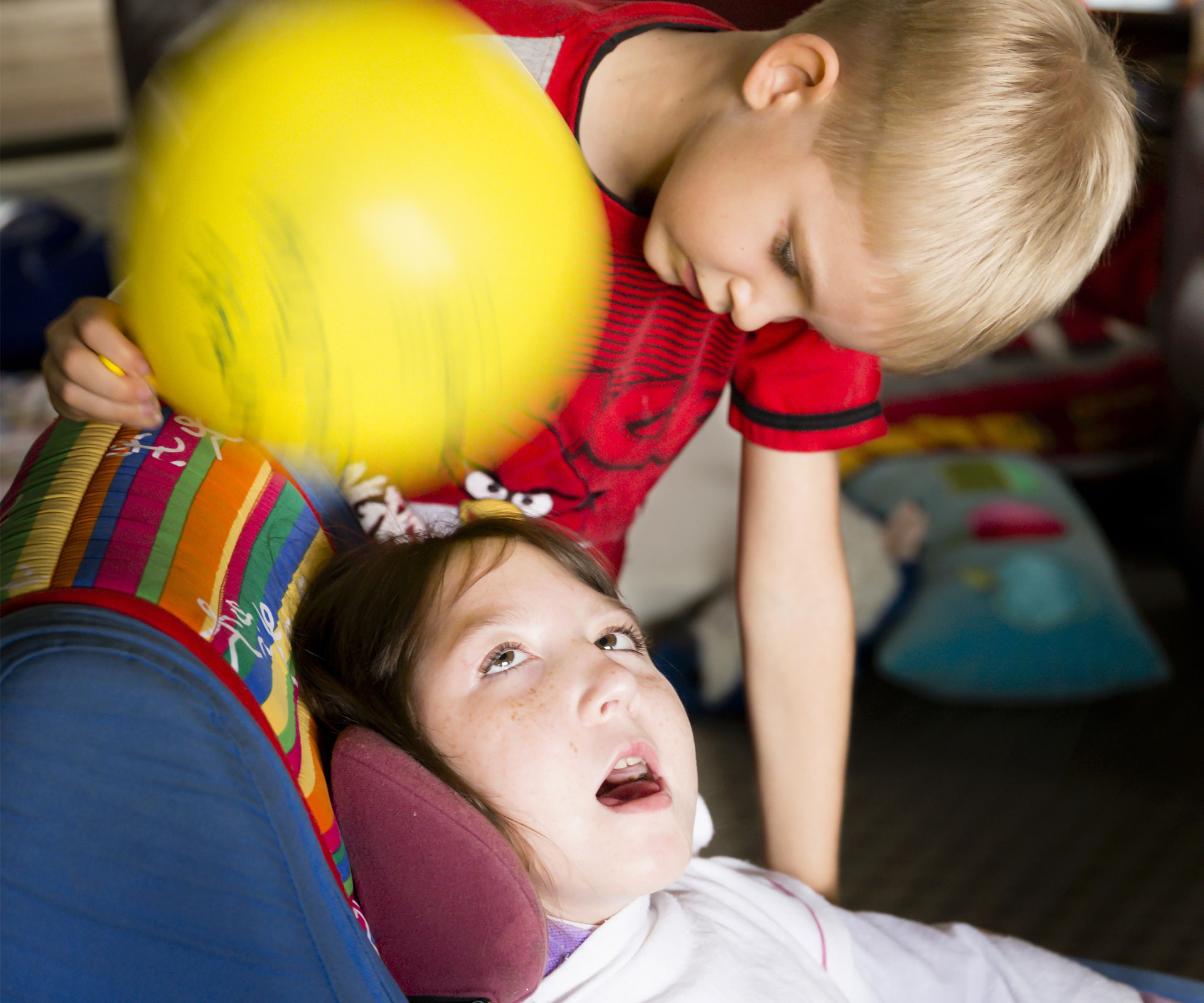
Zak Hooper with his sister
Charley was 16 months old and Zak just born when the Hoopers first read a newspaper report, in January 2007, of a controversial treatment carried out five years earlier in the US, by Seattle endocrinologist Daniel Gunther, on “Ashley X”, a profoundly disabled six-year-old girl. It involved using high doses of the hormone oestrogen to speed up the closure of her bone plates so she would never grow any taller, and the surgical removal of her uterus and breast buds.
The news unleashed a storm of outrage. Disability groups held weeks of protests across the US, describing it as “invasive medical experimentation”, “mutilation”, “desexualisation” and a violation of Ashley’s human rights. Some critics even asked why they didn’t just cut off her arms and legs if they wanted to make her shorter and lighter – after all, she wasn’t using them. An investigation concluded the therapy was illegal, and should not have gone ahead without a court order. Ethicists chimed in both for and against.
At home in the Waikato, the Hoopers saw something very different – hope. Imagine, if you can, what their lives were like. Charley was having about 12 seizures an hour and, in the early months, “before she met Valium”, she screamed for 23 hours a day. She slept only with exhaustion.
“We lived in Morrinsville then and we backed on to a school with a paddock and a cricket pitch,” says Jenn. “I’d climb over the fence and go and sit on the cricket pitch and watch the house to make sure it didn’t burn down. It was the only place I could go without hearing her screaming. I’d go down to get the groceries in the middle of the night and I swear, I’m in the car by myself but, by God, I can hear her and she’s screaming. It messed with us so bad. I said to Mark, ‘I don’t want her like this. I just don’t want her. I didn’t sign up for this.’ It was anger. We’re forced into this terrible position of having to watch our child suffer all day, every day.”
Yes, she admits, there was rejection. “I’ve always been quite honest about this and it’s probably shocking for some parents. I’ve never been completely bonded, as you should be, to Charley. When you hear other people say with their really disabled children, ‘Oh, I wouldn’t have them any other way.’ Well personally I’m not going to judge you – whatever gets you through, that’s fine. But I look at that and think if that was me, there’s no way I could say that, honestly. I’d either be lying, I’d be in denial, or I’d be a crazy person. Who would choose to have your child like this? Why would you possibly want that rather than a normal healthy child?”
She made a deal with Mark in those early days. “The deal was, I’ll give you and Charley the best possible two years I can. I’m going to try everything. We imported glyconutrients from America, we had cranial osteopathy, we had therapists. I said if, after that, we haven’t seen any kind of improvement, then I don’t know that I want to do this all my life and I’d look at seeing if there’s some way I can give her up then.” It was never raised again. “I think Mark always knew. And I probably knew as well. I just needed to have a get-out-of-jail-free card, almost. It’s tough to admit stuff like that.”
And then came Ashley. “Mark and I looked at each other and just thought – that’s amazing. Imagine if we could do that. We’d already had an insight into how much more difficult things were going to be for Charley as time went on. I used to look after disabled people in their own homes, and they were nowhere near as disabled as Charley. She was as severe as you can be without being dead.”
Jenn immediately emailed Ashley’s doctors, joined “Pillow Angels”, a group set up by her parents, and tried to talk to paediatricians here about the possibility of treating Charley. While the response from overseas was supportive, the doctors they first approached back here wouldn’t even discuss it. She says one surgeon who seemed “disgusted by the whole idea” told her: “Put it this way, I would never, ever consider messing around with my children’s hormones.”
“Well, of course he wouldn’t, why would he? They’re normal healthy children. And aren’t you lucky? Aren’t you bloody lucky you’ve never been put in a position to have to contemplate radical things like this for your child’s comfort?”
A specialist who said he would refer the Hoopers to leading developmental paediatrician Rosemary Marks, based at Auckland’s Starship Hospital, did nothing about it for a year. “I went back and said, ‘I wanted to leave you to it, but this is our lives and a decision we wanted to be able to make, and to do that we need more information,’” Jenn says. “The feeling seemed to be, ‘Let’s make it difficult and hope she goes away.’”
By the time the Hoopers finally got to see Marks another eight months later, Jenn had already tracked down Starship paediatric endocrinologist Paul Hofman, who surprised them by being open to a consultation. A consultation, yes, but at that point, not at all open to the possibility of treating Charley.
“I was very negative,” Hofman admits. “I rejected it outright. I said, this isn’t acceptable. You cannot do surgery and a therapy which is potentially dangerous – using high-dose oestrogen can cause thrombosis and clots and a range of adverse side effects.”
After meeting them, however, he agreed to apply to the Auckland District Health Board’s clinical ethics committee for the go-ahead to start the treatment. So what changed? The Hoopers, he says, had thought about the therapy very carefully – “a lot more than I had” – and their justification was “very reasonable, very rational. The compelling argument is where is a child best cared for and I think all of us would say that’s within the family, particularly when you have a loving family who can cherish their child.” He says the Hoopers’ very real concern for the future was they would be less able to care for Charley at home.

With her height now at a maximum 125cm, Charley will still be able to enjoy the outdoors as she gets older – activities that may be impossible if she was the size of an adult.
But Jenn says no matter what, Charley was always going to be cared for at home. “That’s the easy part. You can adapt your house.” But taking Charley outside the home would be far more difficult at adult size, narrowing her opportunities for essential movement, socialisation and different experiences, such as riding on the family’s jetski. “I can’t expect society to take everything so far that it’s doable for us, with ramps and elevators and plinths. So if you can’t make Charley fit their box, you have to make a new box.”
Mark and Jenn Hooper spend six to eight hours a day feeding Charley, when most children this disabled are fed through a gastrostomy tube. They do it because it’s one small thing Charley can do – despite the urgings of doctors who’ve said it would be so much easier with a tube.
Says Jenn: “One of the doctors said that with a tube, ‘you can just plug her in at night.’ I said, ‘What is she? A battery?’ We don’t do this because it’s fun. It helps keep her gag reflex strong, it’s a taste sensation and it’s a whole bunch of time that someone has to be hands-on with Charley.”
It’s ironic, Hofman says, that growth attenuation therapy, as the Ashley hormone treatment is now known, used to be done 30 years ago for social reasons, to stunt the growth of healthy girls who would have been very tall.
With Hofman onside, the Hoopers then met with Marks, who Jenn says was also initially against the treatment, and also changed her mind after meeting the family, agreeing to join Hofman in the ethics application.
Somewhat surprisingly, ethics committees do not meet with the families its opinions will affect, only with the clinicians. By July 2009, in an apparently split opinion, the committee gave the therapy the thumbs-down, saying there would have to be a “clearly measurable benefit” to Charley before it should be considered. It said the procedures were intrusive and not without risk, and the hormone therapy prolonged. “We are not satisfied the evidence for either the social or medical benefits are clear enough to outweigh the possible burdens to this child.” In somewhat woolly reasoning, the committee added that while it didn’t fully understand what the current system of care for severely disabled people involved, “it is not obvious that growth attenuation is superior”.
Jenn Hooper, while upset and disillusioned that she hadn’t been given the chance to argue her case, was undeterred. What if, she had Hofman ask, she found someone who’d start the treatment overseas? Could the treatment then continue at home? Yes, the committee agreed. It could. Within three months, the family was on a plane to Seoul.
The Hoopers took gifts for him, this South Korean paediatric endocrinologist – their “hero” – who agreed to start Charley’s treatment. They’d found him through contacts in the Pillow Angels group and, even though he’d never treated another child with the same therapy, he was prepared to provide the patches which would deliver 50 micrograms of oestrogen each week through her skin.
They caught the subway to the hospital, carrying four-year-old Charley up the many flights of stairs, lugging her heavy, specially designed wheelchair under their arm. It cost them $15,000 for this trip, for a consultation that lasted just 20 minutes. The specialist was there, with his registrar and a drug company rep. The Hoopers handed over their gifts. A book of New Zealand landscapes with a picture of Charley pasted in the frontispiece, a bag of kiwifruit sweets and a glass koru paperweight.
The specialist pushed the box of oestrogen patches across his desk towards them. “This,” he said, “is my gift to you.” There was no charge.

Jenn holding the first patch just before placing it on Charley’s chest. The treatment that had taken nearly three years to be approved took just three seconds to begin.
There’s a video the family took at Incheon Airport before they boarded their flight home. It shows Jenn peeling off the first patch and placing it on Charley’s chest. The treatment they’d spent nearly three years fighting for took just three seconds to begin. Charley had become the youngest child in the world – and possibly only the fourth or fifth ever – to start the Ashley treatment. The Hoopers have no reason to believe in miracles, but what happened next, was, for them, the next best thing.
Back in New Zealand, within two or three days, they noticed while giving Charley physiotherapy that her muscle tone had relaxed – now they could lift her arms over her head when it was usually hard to get them past her eyeline. About the same time, the seizures that racked her 300 times a day had vanished. And her eyes, which often rolled back in her head, were now at midline. “We used to think it was because she was blind, but now I believe for all those years, it was the pain.”
They’d once considered stem cell therapy. Though they knew it would never get Charley walking and talking, it might be worth a try if it could improve her muscle tone and contractions, decrease her seizures and bring her eyes down. They didn’t go ahead with the treatment, because there was no evidence it would work. “We stick a patch on a child and look what happens. That’s the craziest thing.”
“It was a complete surprise,” says Hofman. But it was possibly not as unexpected as it might have been, given there’s a type of epilepsy associated with periods, in which seizures become markedly worse around menstruation. Treatment with sex steroids stops the periods, and the seizures. Oestrogen also seems to quieten nerve activity to the muscles, reducing contractures and spasm.
Mark Hooper had always nursed another small hope for Charley. He told a television documentary on maternity care in 2009 that all he wanted was to see her smile. Now, finally, after four years and two months, he did.
Two of the most contentious parts of the Ashley treatment are the removal of a child’s breast buds and uterus. In Charley’s case, the high-dose oestrogen so inhibited her breast growth the surgery wasn’t necessary, but in December 2012, at the age of seven, she had a hysterectomy. With a family history of painful periods and excessive blood loss, Jenn Hooper says the operation was always going to be in Charley’s best interests. “There was a really high probability Charley would experience the pain and couldn’t tell us. Unlike you and I who go through nasty things, we do it because we think we are probably going to function as parents later on. We took away an essentially useless organ that was going to cause her in all likelihood nothing but pain and discomfort. It wasn’t anything to do with being easier to look after. We are already changing nappies anyway.”
Critics suggest that sterilising severely disabled girls takes away their right to experience womanhood. “Really? If you give your kid Pamol for a sore stomach, aren’t you taking away their right to feel pain? I just don’t get it. At the same time we argue removing a breast or uterus because a woman has cancer doesn’t take away their femininity. You can’t have both arguments.
“Charley wasn’t going to experience anything good about being a woman – the procreation, the sex life, the getting married. We didn’t take that away, the midwives already did that. [The Health Commissioner found the midwives had breached the code of patient rights and ordered them to apologise.] You got a problem, you go and talk to them.”
Pregnancy wasn’t the worry, she says. “If she ever got pregnant, it’d be because we let our guard down and someone had abused her and it’s that abuse that would have haunted us far more than a pregnancy. Kids like Charley don’t have a hope in hell of stopping anything or telling us about it afterwards.”
Before the operation, alternatives were discussed with the gynaecologist and discarded. With Charley vomiting often, oral contraceptives to control periods couldn’t be relied on and, says Hofman, “hormonal options all have negative consequences” when used indefinitely. Jenn Hooper also felt a hormone-exuding IUD was inappropriate, not least because of the size and dose of a device designed for adults.
“It might sound really odd, but it just wasn’t okay. We have to do all sorts of things to Charley. We have to pull her baby teeth out because her brain is so damaged it forgot to grow enamel. We have to suction her nose and stick medication up her jacksie. We thought, we already have to do all this other kind of stuff to her, surely there’s one place on this little girl that we could reasonably confidently leave alone for all her life.” Since the hysterectomy, says Jenn, Charley has rarely cried.
When Charley’s years of oestrogen therapy ended last October, three years and 10 months after her first patch, her bone age was 15 years. She is about 125cm (nearly four foot two) and now will never get taller.
At 23kg, she is still relatively heavy to carry, but Jenn and Mark Hooper lift her dozens of times a day, in and out of the car, in and out of bed, on and off mattresses. They go to the park, to the mall, and a couple of afternoons a week, to the local school where Charley and Zak are enrolled and the kids line up to take turns to push her chair around the playground. The smile is back on her face as the children crowd around her and brush and plait her long brown hair.
“She’s like a living doll, to them,” says Jenn. “They love playing with her – she’s not going to take their toys or be mean to them. They learn not everyone can walk or talk. They learn tolerance and Charley likes the noise, the sound of their voices, and the balls bouncing. It’s good for them all.”
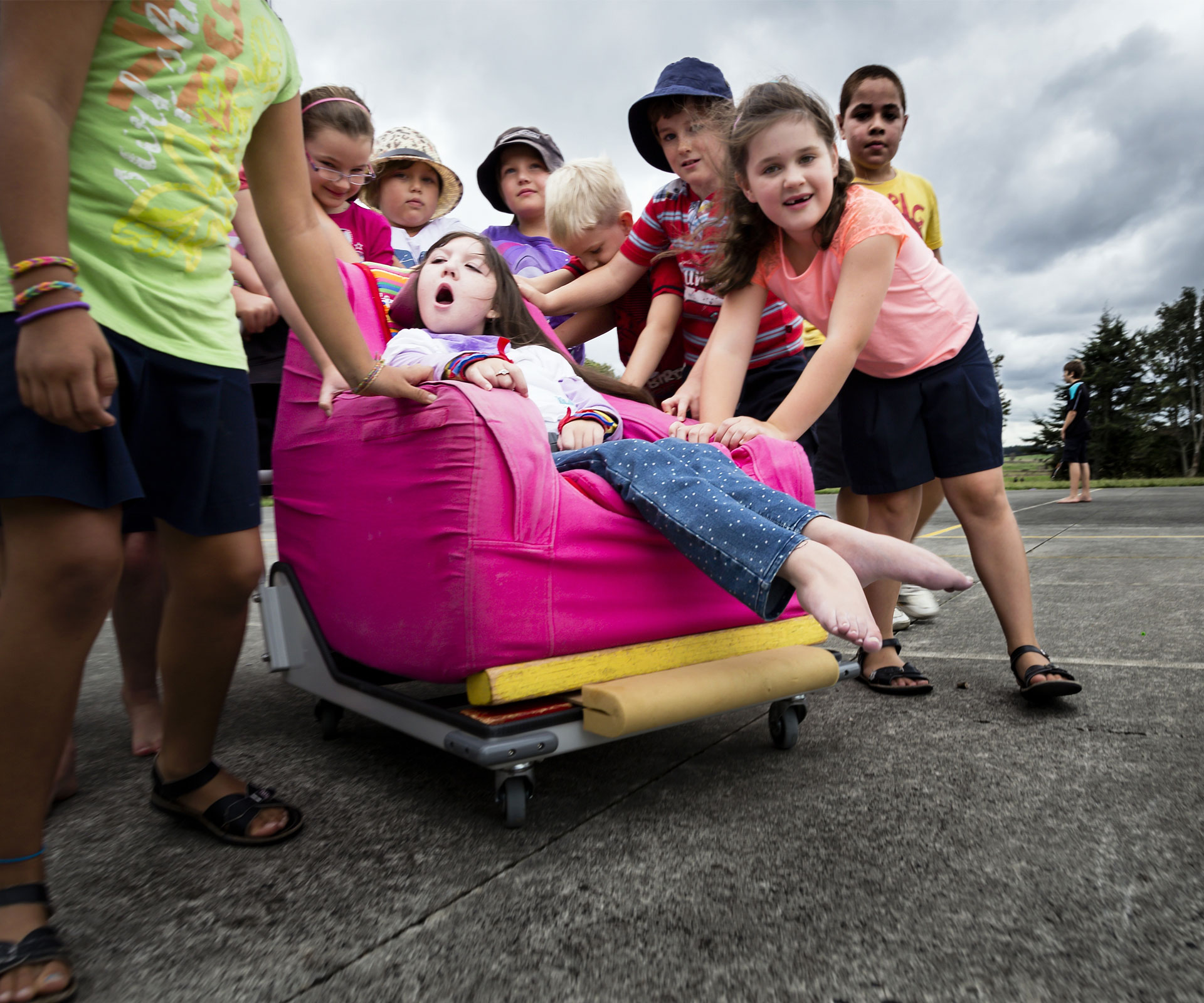
The children at the local primary school regard Charley as a “living doll”.
While life is easier now, it’s still tougher than most of us could ever imagine. Jenn or Mark checks on Charley each hour through the night. She is on a CPAP machine which delivers oxygen through a mask – if that comes off, with the reduced muscle tone that comes with sleep, she could stop breathing. She’s just undergone major surgery to fuse her vertebrae and insert rods to keep her spine straight – scoliosis had made her body horribly misshapen. They still carry a plastic cup for her vomit, she’s still on a cocktail of drugs, including Valium and painkillers.
“It’s relentless. Every aspect of it,” says Jenn. “We have appointments coming out our ears – physios, occupational therapists, spine orthotics, hip orthotics, botox injections, GP visits.” Fortunately, ACC – after another protracted fight – finally accepted cover for her care. Jenn and Mark are full-time carers for Charley. After she was born, Mark kept his job as an architectural draftsman for two years before eventually it became too much. He now chairs the school Parent Teacher Association. It gives them something, other than Charley and Zak, to talk about. “We don’t have a lot of friends. People don’t know what to say a lot of the time. We don’t have things in common with people any more,” says Jenn. “We don’t have other jobs.”
Jenn’s life now revolves around the children and the advocacy group she helped establish, AIM – Action to Improve Maternity. It supports more than 500 families whose children have died or been damaged at birth, and lobbies for improvements in maternity care. The family is working through a bucket list they devised for Charley. They’ve already ticked off a “wheel-on” part in Shortland Street and slid down a snowy slope on a rubbish bag, but there’s more to do. Be a flower girl. Go on a cruise. Take a mud bath. Go on a log flume ride. Fly first class. Take a ride in a helicopter – that’s not an emergency.

Those are the dreams, says Jenn. But the best reality is that Charley will always be warm and dry, clean and fed, cuddled and stimulated – and loved. “With Charley’s level of disability, I’m not sure we can do better than that.”
With the treatment over, they’re confident that they’ve done the right thing for Charley. “There’s really no doubt in my head whatsoever. We haven’t restricted her life in any way. It’s not like she’s ever going to say, ‘Well, godammit, Mum, I could have been a cop if you hadn’t stunted my growth.’ Charley’s entire brain was broken. There was no healthy part left, there was no hope.”
The Hoopers want their story to encourage doctors to openly discuss growth attenuation therapy with other families who might need it. “We were avoided, and those who didn’t avoid us made no secret about their absolute disdain at the very idea. I want them to know this isn’t the big massive scary, awful thing it was first thought to be. We should, as families trying to make any kind of health decision, be allowed the freedom to an open discussion. I wasn’t given that.
“This was climbing a mountain. It was absolutely climbing a mountain. We didn’t just pick up the newspaper and say, ‘Hey, look, we want one of these.’ It was incredibly well considered, as it should be each and every time.
“We want to let the doctors know we have the right to talk about it. Don’t make us go underground. Don’t make us go overseas. Answer the damned questions because you’re the professionals. You owe us that.”
Jenn and Mark Hooper have tried for the past five years to give Zak a healthy sibling. After four privately funded IVF cycles, five miscarriages and “a lot of broken dreams”, they finally accept that in many ways, he is an only child. “We would have loved to have been able to watch our kids play together and be there for each other into adulthood,” she says. “We would have loved to fill our home with children and we’re sad this can’t happen. Zak is our potential now. He’s the future.”
People often ask, with a rather casual brutality, how long Charley has to live. No one knows.
“It’s a terrible situation to be in,” says Jenn. “Somehow we have to get our heads around the fact she could die any old day. She already nearly has a few times. But, simultaneously, we also have to plan that she’s going to be here forever. And I actually don’t know which one to wish for.”
For more information on Action to Improve Maternity, go to www.aim.org.nz.
Photography by: Adrian Malloch
Published in: North & South in June, 2014.
Jenn Hooper gave birth to third child Cody, conceived naturally, in February this year.

